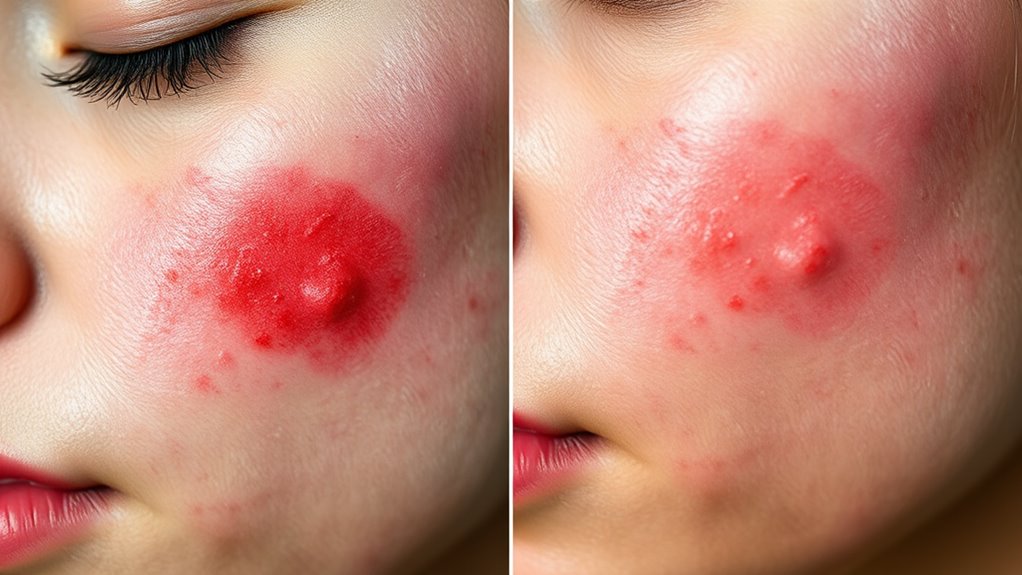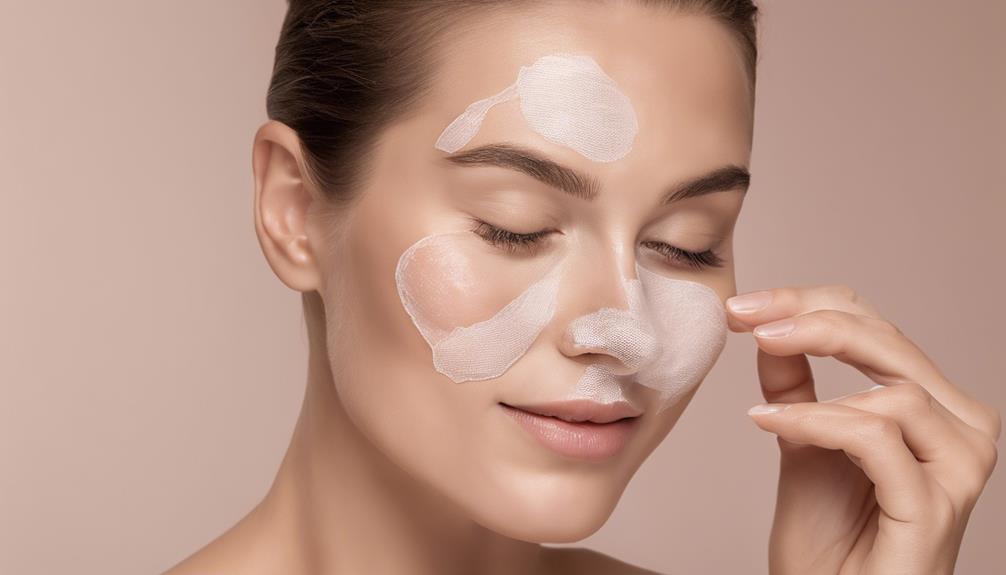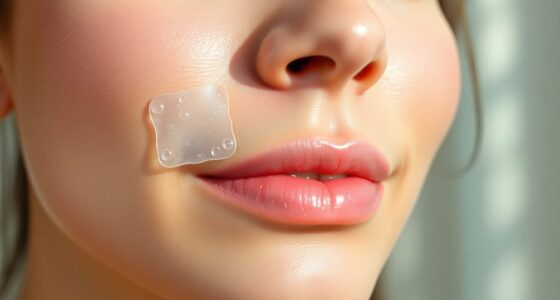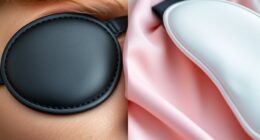Pimple patches can be a game-changer for your acne treatment. These adhesive stickers, made from hydrocolloid, absorb excess fluid and create a protective barrier over blemishes. Many users see significant reductions in size and redness overnight. Their effectiveness varies, depending on the type—whether medicated or non-medicated. However, they have limitations, especially with deeper cystic acne. Curious about how to choose the right patch for your skin type? There’s more to explore on this topic!
Key Takeaways
- Pimple patches effectively reduce the size and redness of surface-level pimples, as evidenced by visible before-and-after results in many users.
- Clinical studies highlight significant improvements in pimple size and inflammation after using hydrocolloid patches consistently.
- Medicated patches with salicylic acid or benzoyl peroxide show enhanced results for inflamed lesions, providing noticeable changes over time.
- Many users report faster healing and reduced irritation in before-and-after photos when using hydrocolloid patches on open blemishes.
- While results vary, before-and-after images often demonstrate the effectiveness of pimple patches for managing surface acne effectively.
Understanding Pimple Patches: What Are They?

When you’re dealing with a breakout, pimple patches can be a game changer. These adhesive stickers, also known as acne patches, provide a targeted, convenient, and discreet way to treat individual pimples.
Usually small and round, they create a protective barrier over your blemishes, preventing further irritation and possible infection. Made from materials like hydrocolloid, they absorb excess fluid and promote healing while blending seamlessly with your skin. Pimple patches are designed for targeted, convenient, and discreet treatment of breakouts.
You’ll find various types available, including medicated options infused with salicylic acid or calming ingredients like centella. While they’re particularly effective for surface-level pimples and inflammation, keep in mind they won’t cure all acne types or prevent future breakouts.
Using them can help manage those occasional flare-ups effectively.
How Do Pimple Patches Work?

Pimple patches work by utilizing a unique combination of materials and mechanisms that target acne effectively. Primarily made from hydrocolloid, these patches create a moist environment that promotes healing. They absorb excess fluids, pus, and impurities, leading to reduced size and inflammation of the pimple. When the patch swells and turns white, it indicates effective fluid absorption. Additionally, some patches contain active ingredients like salicylic acid or tea tree oil to combat bacteria and inflammation. This is particularly beneficial for acne-prone skin, as the patches help manage breakouts more efficiently.
Types of Pimple Patches: Choosing the Right One
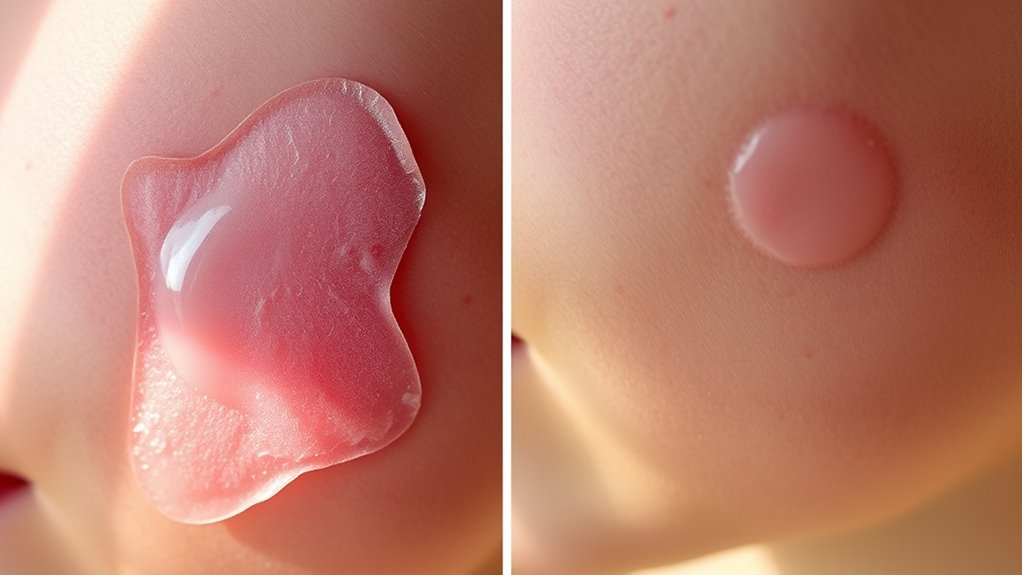
Choosing the right pimple patch can make a significant difference in how effectively you treat acne.
Start by evaluating your blemish type. Hydrocolloid patches work best for surface-level pimples, absorbing excess fluid and pus. If you’re dealing with inflammation, medicated patches containing salicylic acid or benzoyl peroxide can reduce bacteria and swelling. Hydrocolloid technology in patches helps draw out infection while keeping skin moist. For deeper acne, consider microneedling patches that deliver active ingredients below the skin’s surface. Be mindful of your skin type; if you have sensitive skin, opt for patches with gentle adhesives like silicones or hydrogels.
Effectiveness of Pimple Patches: Real Results
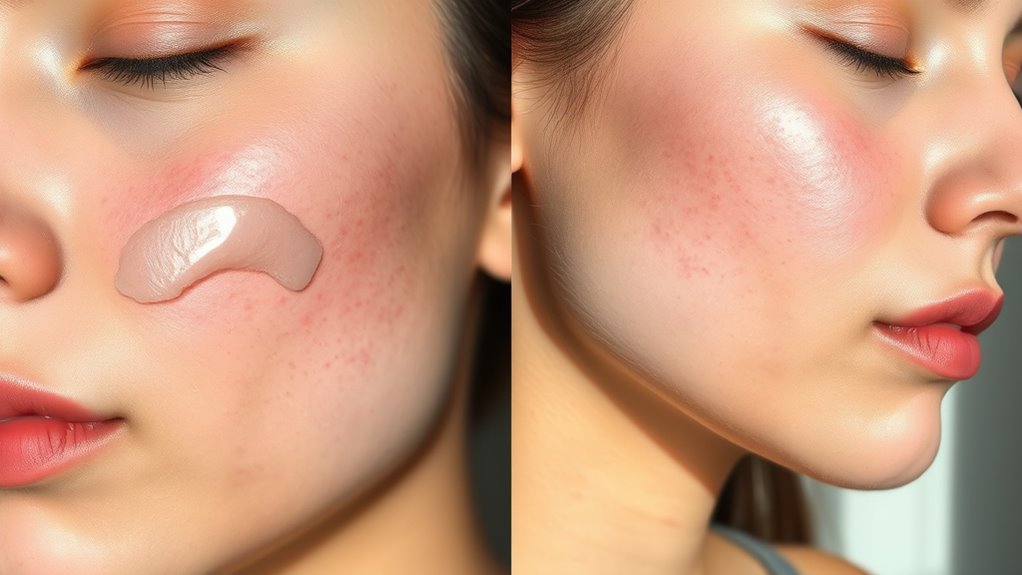
After selecting the right pimple patch for your skin type and blemish, it’s important to understand how effective these products can be in real-world scenarios.
Hydrocolloid patches excel at treating surface-level pimples by maintaining a moist environment that promotes healing and absorbs excess oil. They create a protective barrier that reduces the chance of infection and prevents you from picking at your acne, which can lead to scarring. This unique ability to soak up infected fluid is what makes them particularly effective for open pimples. Clinical trials show they can considerably decrease redness and pimple size over time. However, keep in mind that these patches are less effective on deep cystic acne and won’t prevent future breakouts.
For best results, integrate them into a broader skincare routine tailored to your specific needs.
User Experiences: Before-and-After Transformations

How do users really feel about their experience with pimple patches? Many report high satisfaction, especially when they see rapid improvements in their skin.
Users love how the patches visibly change from transparent to opaque white as they absorb pus, providing instant proof of effectiveness. You might notice reduced inflammation and redness, which boosts your confidence almost immediately. Additionally, these patches contain alpha-arbutin to inhibit melanin production, enhancing their effectiveness in treating hyperpigmentation.
Users appreciate the visible transformation of patches from clear to white, proving their effectiveness while reducing inflammation and boosting confidence.
Over time, regular use can lead to clearer skin and improved texture, making you feel even better about your appearance. Plus, by preventing the urge to pop blemishes, these patches help minimize scarring.
With a growing number of testimonials and before-and-after photos circulating online, it’s no wonder pimple patches have become a popular skincare staple!
Application Tips for Maximum Results

To achieve the best results with pimple patches, it’s crucial to apply them correctly and with the right preparation.
Start by choosing the right patch type; hydrocolloid patches work wonders on whiteheads, while medicated ones tackle inflamed pimples.
Cleanse your skin with a gentle, non-comedogenic cleanser and dry it thoroughly. Avoid heavy moisturizers, opting for a light toner instead.
When placing the patch, center it over the blemish and press down gently to secure it. Additionally, make sure to consider skin type when selecting your patch to ensure it meets your specific needs. Leave it on for at least 6 hours, ideally overnight.
After removal, follow up with your regular skincare routine to support recovery. If the pimple persists, feel free to apply another patch for continued treatment.
Limitations of Pimple Patches: What to Know
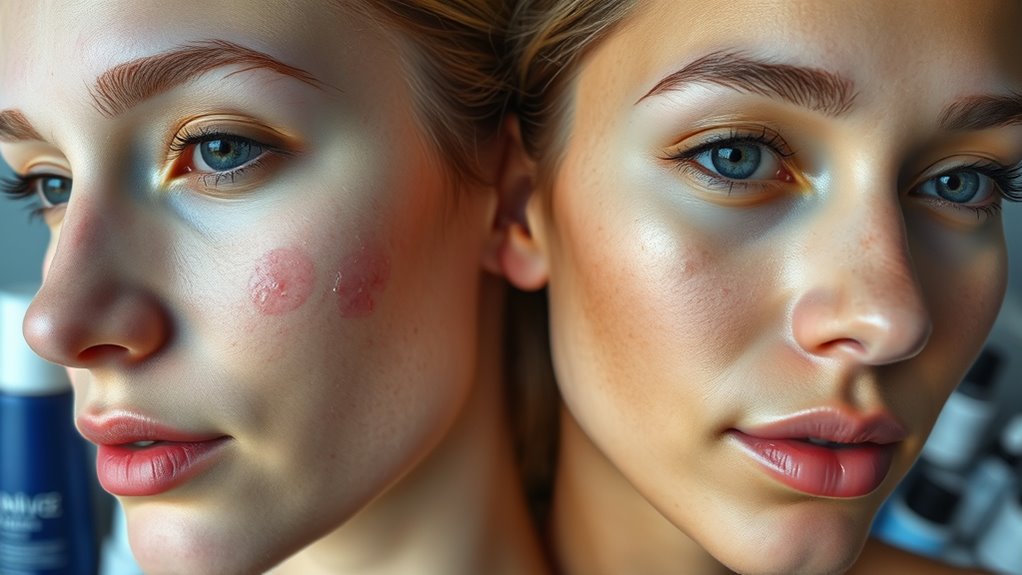
While pimple patches can be a handy tool for treating surface-level acne, they come with notable limitations that you should be aware of.
For starters, they’re ineffective on deeper cystic acne, as they can’t penetrate the skin well. Additionally, pimple patches only treat existing blemishes and won’t prevent future breakouts. It’s essential to recognize that pimple patches are best for open whiteheads, as they aren’t effective for closed lesions or blackheads.
If you have sensitive skin, be cautious; some ingredients can cause irritation. It’s also important not to apply patches to open wounds, as this can trap bacteria.
While microneedle patches may deliver ingredients deeper, standard patches have limited effectiveness. Ultimately, overusing them can lead to unnecessary irritation.
Always consider these factors to get the most out of your acne treatment.
Incorporating Pimple Patches Into Your Skincare Routine

Pimple patches can be a valuable addition to your skincare routine, especially when used effectively. Start by cleansing your skin thoroughly and ensuring it’s dry for ideal adhesion. Apply the patch as the last step in your nighttime routine, allowing it to work overnight. For daily use, choose discreet patches that blend with your skin tone, making them suitable for daytime wear. Consistency is key—regular application enhances their effectiveness in managing breakouts. Additionally, these patches help reduce irritation and prevent infection by keeping dirt and bacteria away. You can also combine them with other treatments for extensive care. Remember to choose patches with high-quality hydrocolloid and beneficial ingredients like salicylic acid or tea tree oil for added healing power. With the right approach, you’ll see significant improvements in your skin.
Comparing Medicated vs. Non-Medicated Patches
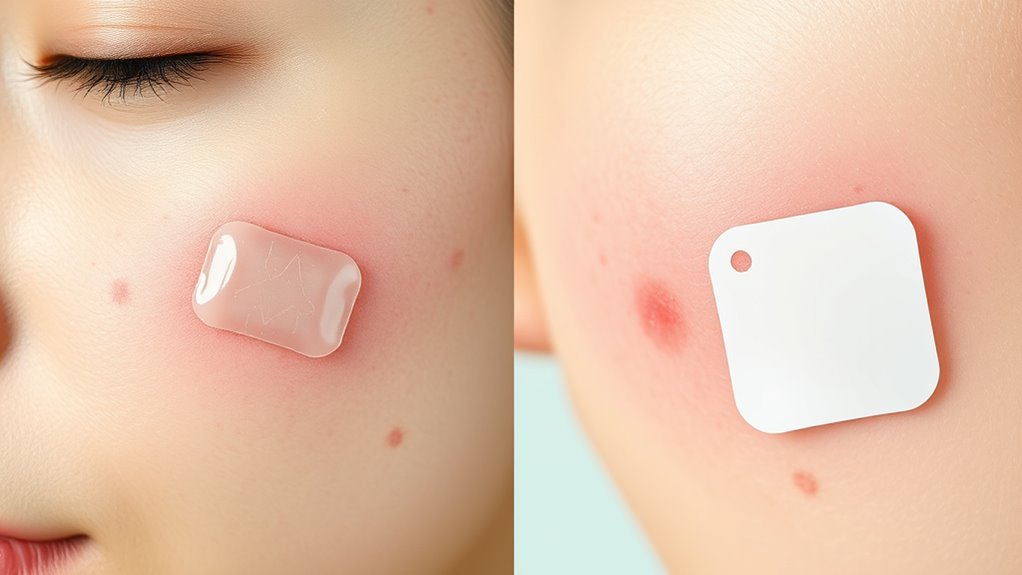
When deciding between medicated and non-medicated pimple patches, understanding their unique benefits can make a significant difference in how you tackle breakouts.
Medicated patches contain active ingredients like salicylic acid and tea tree oil, targeting inflammation and bacteria effectively. They’re great for inflamed lesions but may irritate sensitive skin. Additionally, hydrocolloid patches serve as protective bandages for breakouts, creating a barrier that helps expedite healing.
On the other hand, non-medicated patches primarily use hydrocolloid, creating a moist environment that soothes and absorbs excess fluids, making them ideal for open, oozing pimples.
While non-medicated options provide quicker results for surface pimples, medicated patches offer deeper treatment for tougher acne.
Ultimately, your choice should depend on your specific skin type and the type of acne you’re dealing with to maximize healing benefits.
When to Seek Professional Help for Acne
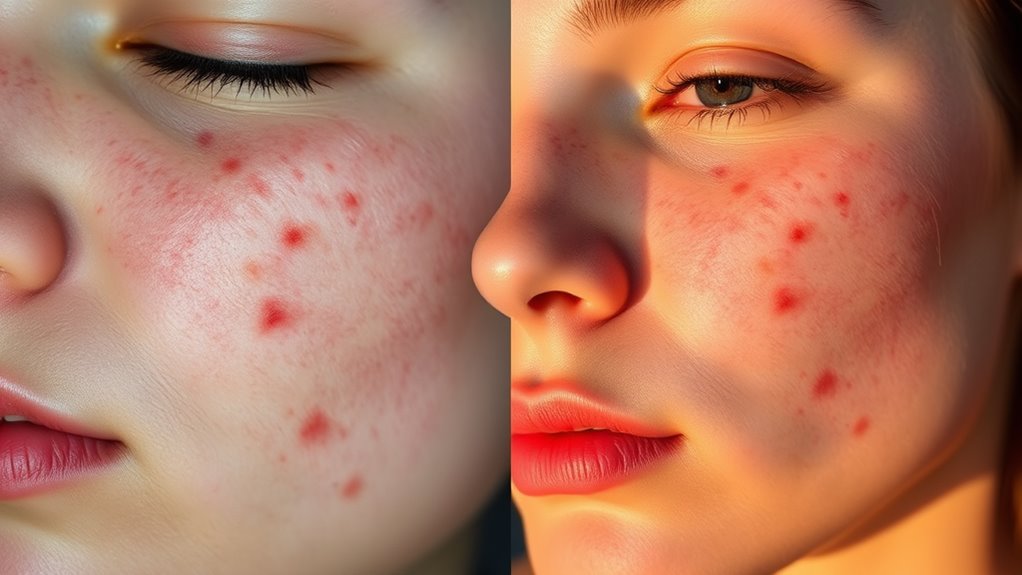
How can you tell if your acne requires professional intervention? If you’re dealing with severe forms of acne—like cystic or nodular acne—it’s time to seek help. These types can cause significant skin damage and emotional distress. If over-the-counter treatments aren’t improving your condition after a few weeks, you shouldn’t hesitate to consult a dermatologist. Additionally, if you notice excessive redness, swelling, or painful lesions, it’s a sign that you need professional advice. Remember, dermatologist intervention can provide effective treatment options for severe cases. Don’t ignore persistent acne that leaves scars or dark spots; a specialist can provide tailored treatments that work. Early intervention can prevent further complications and help you achieve clearer skin faster, as financial planning during this process can also reduce anxiety related to treatment costs. Taking that step could be the key to regaining your confidence!
Frequently Asked Questions
Can Pimple Patches Be Reused or Are They Single-Use Only?
Pimple patches are designed for single use, so you can’t reuse them.
After one application, they absorb oils and bacteria, which makes them ineffective and potentially harmful if reapplied. The adhesive wears out, and reusing could prolong healing and increase irritation.
For the best results, always use a fresh patch on each blemish. Follow your skincare routine, and apply patches as soon as you notice a breakout for peak effectiveness.
How Long Should I Leave a Pimple Patch on for Best Results?
“Good things come to those who wait.” For the best results, you should leave a pimple patch on for 6 to 8 hours.
If you’re using it overnight, it’s ideal to keep it on for 8 to 12 hours. The patch absorbs impurities and provides a protective barrier, so remove it once it turns white or starts peeling.
Following these guidelines helps guarantee you’ll see visible improvements in your blemish’s condition.
Are There Any Age Restrictions for Using Pimple Patches?
There aren’t strict age restrictions for using pimple patches, but it’s best to take into account a few factors.
If you’re a younger user, like a teen, check with a parent or guardian before trying them out.
Most patches are safe for adults, but everyone’s skin reacts differently.
Always read the product instructions and consult a dermatologist if you have concerns.
You want to make sure you’re using them correctly for the best results!
Can I Apply Makeup Over a Pimple Patch?
Can you really wear makeup over a pimple patch? Absolutely! Applying makeup over a pimple patch not only helps camouflage breakouts but also protects your skin.
Start with a clean, dry patch, then use lightweight foundation or concealer for natural coverage. A gentle touch keeps the patch in place, while translucent powder reduces shine.
Just remember to choose matte products for the best results and avoid skincare products underneath the patch.
Do Pimple Patches Expire or Have a Shelf Life?
Yes, pimple patches do have a shelf life.
Hydrocolloid patches can last up to three years if unopened, but those with active ingredients like salicylic acid often have expiration dates, usually ranging from six months to two years.
Using expired patches can lead to reduced efficacy and potential skin irritation.
To maximize their effectiveness, store them in a cool, dry place, and always check the packaging for specific expiration dates.
Conclusion
Incorporating pimple patches into your skincare routine can be a game-changer for those pesky breakouts. With their targeted approach, you might just find the relief you’ve been searching for. Have you ever wondered how satisfying it feels to wake up and see clear skin? While these patches work wonders for many, remember they’re not a one-size-fits-all solution. Keep experimenting and find what suits you best, because you deserve to feel confident in your skin every day.
